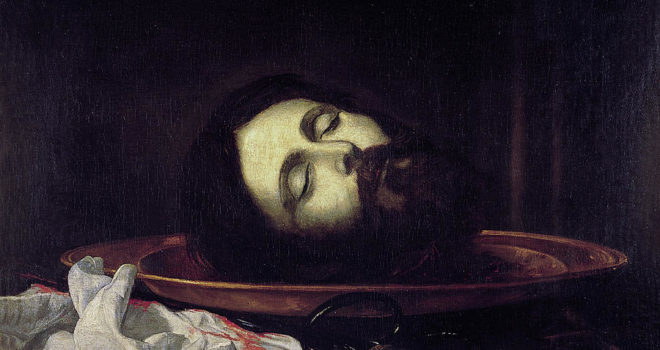From Catholic Exchange:
ShareIf we look to Jerusalem, we find the Feast of the First Finding of the Head of St. John the Baptist, commemorated on February 24th. According to the tradition, after St. John’s death, the head of the Baptist was taken by Joanna, wife of Chuza, and buried on the Mount of Olives where it remained hidden for centuries. Sometime in the fourth century, a wealthy convert named Innocent, purchased a plot of land on the Mount of Olives, intending to live as a monastic there. Whilst digging the foundation for his cell, he uncovered a vessel containing the head of St. John.
The Second Finding of the Head of St. John the Baptist is a complex, convoluted tale. During the reign of Constantine (313-337), two monks on pilgrimage to Jerusalem had a vision in which St. John revealed the location of his head. The men accordingly found the relic, placed it in a sack, and returned home. However, on route they ran into a certain potter who was instructed in a dream to take the head from the monks, whose dissolute lives had offended the saint. The potter took the head, placed it in his sack, and fled. He retained it in his home until death, at which point the head passed first to his sister and eventually into the hands of a Greek hieromonk of Emesa named Eustacius.
Unfortunately, this Eustacius was an Arian who used the head of St. John as a means of attracting followers to his heresy. The sick who came to Eustacius were healed by virtue of the head. Eventually, however, Eustacius was driven out of Emesa. The head was buried, and a monastery grew up here, but the exact location of the head was forgotten.Years later, in 452, the head of St. John the Baptist was uncovered a second time. According to multiple sources from the 5th century, the head was uncovered in the Emesa monastery on February 18th, 452. Bishop Uranius of Emesa established its veneration, and on February 26th of the same year, it was translated to the newly built church dedicated to St. John. These events are all observed on February 24th in conjunction with the observance of the First Finding of the Head of St. John the Baptist.
The Third Finding dates from the 9th century. By then Emesa had fallen under Muslim rule and was known as Homs. The Islamic world was torn by a civil war between the Abbasid and Umayyad dynasties. Around 820, local Christians sent the head of St. John away to the city of Comana in Cappadocia for safe keeping. Unfortunately, veneration of the relic was not permitted due to the prevalent heresy of Iconoclasm. It had to be kept hidden and was again lost. After the restoration of orthodoxy, Patriarch Ignatius of Constantinople was given a vision revealing the exact location of the head. An imperial delegation was sent to Comana to retrieve the sacred relic; it was brought to Constantinople and installed there with great pomp in the year 850. This Third Finding of the Head of St. John the Baptist was commemorated with a liturgical feast on May 25th, the date it was installed at Constantinople. (Read more.)


















No comments:
Post a Comment